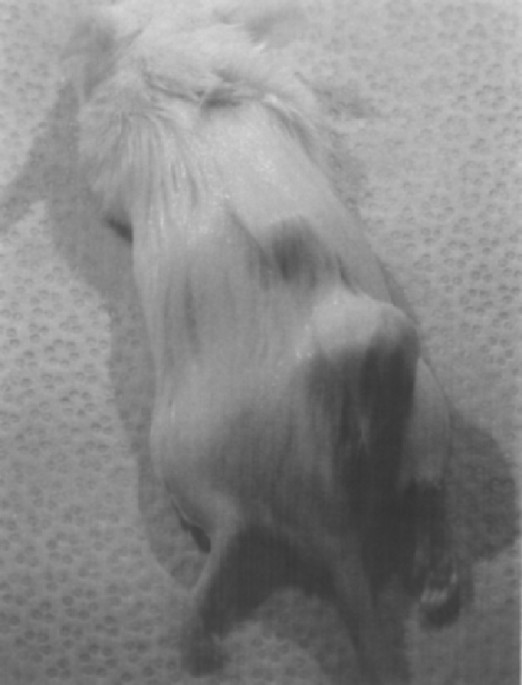
- Select a language for the TTS:
- UK English Female
- UK English Male
- US English Female
- US English Male
- Australian Female
- Australian Male
- Language selected: (auto detect) - EN
Play all audios:
ABSTRACT Peyronie's disease is a localized connective tissue disorder, caused by trauma to the erect penis, which results in cellular proliferation and excess extracellular matrix
production within the tunica albuginea of the penis. We have previously demonstrated that cells derived from Peyronie's disease plaque tissue demonstrate increased cell growth,
increased S-phase on flow cytometry, stabilization and inactivation of p53, and consistent morphologic transformation, all suggesting that these cells are biologically transformed. Severe
combined immunodeficient (SCID) mice have been used extensively to study the pathobiology of malignant and benign tissue and cells. This study was undertaken to determine if Peyronie's
derived fibroblasts had the potential to demonstrate tumorigenicity in the SCID mouse model, thus confirming their biologically transformed nature. Cultured fibroblasts were derived from
three sources, namely, plaque tissue excised from men with Peyronie's disease, tunical tissue excised from young men with congenital penile curvature and neonatal foreskins. BALB/C SCID
mice were divided into three groups and each group was inoculated with cultured fibroblasts from each of the three different sources. All animals were evaluated regularly and maintained in
isolation for a period of 3 months following inoculation. All SCID mice inoculated with cells derived from Peyronie's disease plaque tissue (_n_=10) developed subcutaneous nodules at a
mean time period of 2.5±0.5 months following injection. The mean maximum dimension and weight of the nodules at the time of killing the animal was 1.1±0.2 cms and 0.6±0.2 g, respectively.
Histologically, the nodules were composed of large pleomorphic epithelioid cells with a high mitotic activity, which were negative for cytokeratin but positive for vimentin. None of the SCID
mice inoculated with cells cultured from either normal tunica (_n_=5) or foreskin (_n_=5) developed subcutaneous nodules. In conclusion, the tumorigenic nature of Peyronie's disease
plaque-derived fibroblasts sheds further light on the pathobiologic characteristics of these cells. Specifically, these data confirm that cells cultured from Peyronie's disease plaque
are biologically transformed. Future refinement and study of this animal model may permit a more complete understanding of the pathophysiology of Peyronie's disease and fibromatoses in
general. Furthermore, such an animal model may, in the future, allow a more ready evaluation of the therapeutic interventions for Peyronie's disease. Access through your institution Buy
or subscribe This is a preview of subscription content, access via your institution ACCESS OPTIONS Access through your institution Subscribe to this journal Receive 12 print issues and
online access $259.00 per year only $21.58 per issue Learn more Buy this article * Purchase on SpringerLink * Instant access to full article PDF Buy now Prices may be subject to local taxes
which are calculated during checkout ADDITIONAL ACCESS OPTIONS: * Log in * Learn about institutional subscriptions * Read our FAQs * Contact customer support SIMILAR CONTENT BEING VIEWED BY
OTHERS CANCER-ASSOCIATED FIBROBLASTS STIMULATE PRIMARY TUMOR GROWTH AND METASTATIC SPREAD IN AN ORTHOTOPIC PROSTATE CANCER XENOGRAFT MODEL Article Open access 28 July 2020 CANCER-ASSOCIATED
FIBROBLASTS DOWNREGULATE TYPE I INTERFERON RECEPTOR TO STIMULATE INTRATUMORAL STROMAGENESIS Article 17 August 2020 TGF-Β1 INDUCES FORMATION OF TSG-6-ENRICHED EXTRACELLULAR VESICLES IN
FIBROBLASTS WHICH CAN PREVENT MYOFIBROBLAST TRANSFORMATION BY MODULATING ERK1/2 PHOSPHORYLATION Article Open access 29 May 2024 REFERENCES * Devine CJJ, Jordan GH, Somers RD .
Peyronie's disease: cause surgical treatment. _AUA Today_ 1989; 2: 1. Google Scholar * Jordan G . Peyronie's disease. In: P.C.e.a.Walsh (ed). _Campbell's Urology_. WB
Saunders: Philadelphia, 1992, pp. 2204–2222. Google Scholar * Weidner W, Schroeder-Printzen I, Weiske W, Vosshenrich R . Sexual dysfunction in Peyronie's disease: an analysis of 222
without previous local plaque therapy. _J Urol_ 1997; 157: 325. Article CAS Google Scholar * Lindsay MB et al. The incidence of Peyronie's disease in Rochester Minnesota 1950 through
1984. _J Urol_ 1991; 146: 1007. Article CAS Google Scholar * Schwarzer U et al. Prevalence of Peyronie's disease: results of an 8,000 man survey. _J Urol_ 2000; 163: 167. Google
Scholar * Devine CJJ, Somers KD, Jordan GH, Scholssberg SM . Proposal: Trauma as the cause of Peyronie's lesion. _J Urol_ 1997; 157: 285. Article Google Scholar * Mulhall JP, Thom J,
Lubrano T, Shankey TV . Basic fibroblast growth factor expression in Peyronie's disease. _J Urol_ 2001; 165: 419. Article CAS Google Scholar * El-Sakka AI et al. Peyronie's
disease is associated with an increase in transforming growth factor beta proetin expression. _J Urol_ 1997; 158: 1391. Article CAS Google Scholar * Yamanaka M et al. Genetic Instability
in Peyronie's disease. _J Urol_ 2001; 165: 201. Google Scholar * Mulhall JP, Thom J, Lubrano T, Shankey TV . Cytogenetic evidence in support of Peyronie's disease being a tunical
field defect process. _J Urol_ 2000; 163: 747A. Google Scholar * Smith BH . Peyronie's disease. _Am J ClinPathol_ 1966; 45: 670. CAS Google Scholar * Ralph DJ, Mirakian R, Pryor JP,
Bottazzo GF . The immunological features of Peyronie's disease. _J Urol_ 1996; 155: 159. Article CAS Google Scholar * Wegner HE, Andersen R, Knipsel HH, Miller K . Treatment of
Peyronie's disease with local interferon-alpha 2b. _Eur Urol_ 1995; 28: 236. Article CAS Google Scholar * El-Sakka A et al. The effects of colchicine on a Peyronie's-like
condition in an animal model. _J Urol_ 1999; 161: 1980. Article CAS Google Scholar * Ahuja S et al. A pilot study demonstrating clinical benefit from intralesional interferon alpha 2B in
the treatment of Peyronie's disease. _J Androl_ 1999; 20: 444. CAS PubMed Google Scholar * Levine LA . Treatment of Peyronie's disease with intalesional verapamil injection. _J
Urol_ 1997; 158: 1395. Article CAS Google Scholar * Anderson MS, Shankey TV, Lubrano T, Mulhall JP . Inhibition of Peyronie's plaque fibroblast proliferation by biologic agents. _Int
J Impot Res_ 2000; 3(12 Suppl): S25. Article Google Scholar * Mulhall JP, Branch J, Lubrano T, Shankey TV . Perturbation of cell cycle regulators in Peyronie's disease fibroblasts.
_Int J Impot Res_ 2001; 13: 21. Article Google Scholar * Bosma G, Custer RP, Bosma MJ . A severe combined immunodeficiency in the mouse. _Nature_ 1983; 301: 527. Article CAS Google
Scholar * Bumpers HL et al. Human villous adenoma engrafted into SCID mice survive for prolonged period with malignant trasformation. _J Clin Invest_ 94; 2153: 1994. Google Scholar *
Ahsmann E et al. The SCID mouse as a model for multiple myeloma. _Br J Hematol_ 1995; 89: 319. Article CAS Google Scholar * Awwad J et al. The SCID mouse: an experimental model for
endometriosis. _Hum Reprod_ 1999; 14: 3107. Article CAS Google Scholar * Fukuda K et al. Morphology and function of human benign tumors normal thyroid tissues maintained in severe
combined immunodeficient mice. _Cancer Lett_ 1998; 132: 153. Article CAS Google Scholar * Mukherji B et al. Spontaneous _in vitro_ transformation of human fibroblasts. _J Natl Cancer
Inst_ 1984; 73: 583. CAS PubMed Google Scholar * Inohara H, Matsunaga T, Nomura T . Growth metastasis of fresh human benign malignant tumors in the head neck regions transplanted into
SCID mice. _Carcinogenesis_ 1992; 13: 845. Article CAS Google Scholar Download references AUTHOR INFORMATION AUTHORS AND AFFILIATIONS * Andrology Research Laboratory, Hines, Illinois, USA
J P Mulhall, D J Martin, T Lubrano & T V Shankey * Department of Urology, Weill Medical College, Cornell University, New York J P Mulhall, D J Martin, E Kwon & T V Shankey * The
Oncology Institute, Cardinal Bernardin Cancer Center, Maywood, Illinois, USA M Moser & E Kwon * Department of Pathology, Loyola University Medical Center, Stritch School of Medicine,
Maywood, Illinois, USA E Wojcik Authors * J P Mulhall View author publications You can also search for this author inPubMed Google Scholar * D J Martin View author publications You can also
search for this author inPubMed Google Scholar * T Lubrano View author publications You can also search for this author inPubMed Google Scholar * M Moser View author publications You can
also search for this author inPubMed Google Scholar * E Kwon View author publications You can also search for this author inPubMed Google Scholar * E Wojcik View author publications You can
also search for this author inPubMed Google Scholar * T V Shankey View author publications You can also search for this author inPubMed Google Scholar CORRESPONDING AUTHOR Correspondence to
J P Mulhall. RIGHTS AND PERMISSIONS Reprints and permissions ABOUT THIS ARTICLE CITE THIS ARTICLE Mulhall, J., Martin, D., Lubrano, T. _et al._ Peyronie's disease fibroblasts
demonstrate tumorigenicity in the severe combined immunodeficient (SCID) mouse model. _Int J Impot Res_ 16, 99–104 (2004). https://doi.org/10.1038/sj.ijir.3901183 Download citation *
Published: 19 February 2004 * Issue Date: 01 April 2004 * DOI: https://doi.org/10.1038/sj.ijir.3901183 SHARE THIS ARTICLE Anyone you share the following link with will be able to read this
content: Get shareable link Sorry, a shareable link is not currently available for this article. Copy to clipboard Provided by the Springer Nature SharedIt content-sharing initiative
KEYWORDS * Peyronie's disease * fibroblasts * fibromatosis * SCID mice * transformation

:max_bytes(150000):strip_icc():focal(216x0:218x2)/benedict-cumberbatch-1-435-4-20cc736017b24435a3498a49d7c22b0e.jpg)






